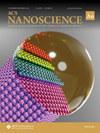Synergistic Effects of ZnO@NiM′-Layered Double Hydroxide (M′ = Mn, Co, and Fe) Composites on Supercapacitor Performance: A Comparative Evaluation
IF 4.8
Q2 NANOSCIENCE & NANOTECHNOLOGY
引用次数: 0
Abstract
The development of supercapacitors is pivotal for sustainable energy storage solutions, necessitating the advancement of innovative electrode materials to supplant fossil-fuel-based energy sources. Zinc oxide (ZnO) is widely studied for use in supercapacitor electrodes because of its beneficial physicochemical properties, including excellent chemical and thermal stability, semiconducting characteristics, low cost, and environmentally friendly nature. In this study, ZnO nanorods were synthesized using a simple hydrothermal method and then combined with various Ni-based layered double hydroxides (LDHs) [NiM′-LDHs (M′ = Mn, Co, and Fe)] to improve the electrochemical performance of the ZnO nanorods. These LDHs are well-known for their outstanding electrochemical and electronic properties, high specific capacitance, and efficient dispersion of cations within host nanolayers. The synthesized composites ZnO@NiMn-LDH, ZnO@NiCo-LDH, and ZnO@NiFe-LDH exhibit enhanced specific capacitances of 569.3, 284.6, and 133.0 F/g, respectively, at a current rate of 1 A/g, outperforming bare ZnO (98.4 F/g). Notably, ZnO@NiMn-LDH demonstrates superior electrochemical performance along with a capacitance retention of 76%, compared to ZnO@NiCo-LDH (58%), ZnO@NiFe-LDH (49%), and bare ZnO (23%) over 5000 cycles. Furthermore, an asymmetric supercapacitor (ASC) was developed by using ZnO@NiMn-LDH as the positive electrode and activated carbon (AC) as the negative electrode to assess its practical applicability. The fabricated ASC (ZnO@NiMn-LDH//AC) demonstrated a specific capacitance of 45.22 F/g at a current rate of 1 A/g, an energy density of 16.08 W h/kg at a power density of 798.8 W/kg, and a capacitance retention of 75% over 5000 cycles. These findings underscore the potential of the composite formation of ZnO with Ni-based LDHs in advancing the efficiency and durability of supercapacitors.

ZnO@NiM′ 层状双氢氧化物(M′ = 锰、钴和铁)复合材料对超级电容器性能的协同效应:比较评估
超级电容器的开发对于可持续能源存储解决方案至关重要,因此有必要改进创新电极材料,以取代化石燃料能源。氧化锌(ZnO)具有良好的物理化学特性,包括出色的化学和热稳定性、半导体特性、低成本和环保性,因此被广泛研究用于超级电容器电极。本研究采用简单的水热法合成了氧化锌纳米棒,然后将其与各种镍基层状双氢氧化物(LDHs)[NiM′-LDHs(M′ = Mn、Co 和 Fe)]相结合,以提高氧化锌纳米棒的电化学性能。这些 LDHs 因其出色的电化学和电子特性、高比电容以及阳离子在宿主纳米层中的高效分散而闻名。合成的复合材料 ZnO@NiMn-LDH、ZnO@NiCo-LDH 和 ZnO@NiFe-LDH 在 1 A/g 电流速率下分别表现出 569.3、284.6 和 133.0 F/g 的增强比电容,优于裸 ZnO(98.4 F/g)。值得注意的是,与 ZnO@NiCo-LDH(58%)、ZnO@NiFe-LDH(49%)和裸 ZnO(23%)相比,ZnO@NiMn-LDH 在 5000 个循环周期内表现出卓越的电化学性能,电容保持率高达 76%。此外,为了评估不对称超级电容器(ASC)的实际应用性,还使用 ZnO@NiMn-LDH 作为正极,活性炭(AC)作为负极。制成的 ASC(ZnO@NiMn-LDH//AC)在电流为 1 A/g 时的比电容为 45.22 F/g,在功率密度为 798.8 W/kg 时的能量密度为 16.08 W h/kg,在 5000 次循环中的电容保持率为 75%。这些发现强调了氧化锌与镍基 LDH 的复合形成在提高超级电容器的效率和耐用性方面的潜力。
本文章由计算机程序翻译,如有差异,请以英文原文为准。
求助全文
约1分钟内获得全文
求助全文
来源期刊

ACS Nanoscience Au
材料科学、纳米科学-
CiteScore
4.20
自引率
0.00%
发文量
0
期刊介绍:
ACS Nanoscience Au is an open access journal that publishes original fundamental and applied research on nanoscience and nanotechnology research at the interfaces of chemistry biology medicine materials science physics and engineering.The journal publishes short letters comprehensive articles reviews and perspectives on all aspects of nanoscience and nanotechnology:synthesis assembly characterization theory modeling and simulation of nanostructures nanomaterials and nanoscale devicesdesign fabrication and applications of organic inorganic polymer hybrid and biological nanostructuresexperimental and theoretical studies of nanoscale chemical physical and biological phenomenamethods and tools for nanoscience and nanotechnologyself- and directed-assemblyzero- one- and two-dimensional materialsnanostructures and nano-engineered devices with advanced performancenanobiotechnologynanomedicine and nanotoxicologyACS Nanoscience Au also publishes original experimental and theoretical research of an applied nature that integrates knowledge in the areas of materials engineering physics bioscience and chemistry into important applications of nanomaterials.
 求助内容:
求助内容: 应助结果提醒方式:
应助结果提醒方式:


